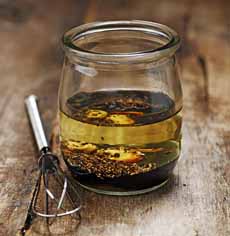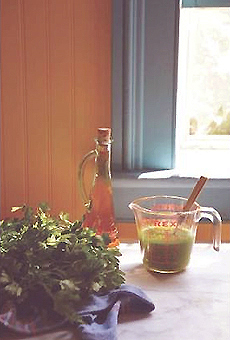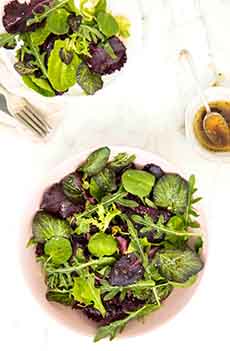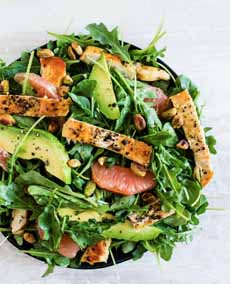TIP OF THE DAY: Make An Herb Vinaigrette Salad Dressing
|
The recipe is below. But first, a brief history of salad dressing. Salad greens were picked and eaten by man, likely from the furthest days of prehistory. But salad dressing came much later. We know from the written record that the Babylonians used oil and vinegar for dressing greens nearly 2,000 years ago. Ancient Egyptians added Asian spices to those basic ingredients. But what about creamy salad dressings that are so popular in the U.S.? Modern mayonnaise was created by the great French chef Marie-Antoine Carême (1784-1833), founder of the concept of haute cuisine. He blended vegetable oil and egg yolks into an emulsion; his recipe that became famous throughout Europe, and subsequently, the U.S. and the world [more about it]. Mayonnaise became the base of creamy salad dressings, even when buttermilk* or blue cheese was added. Salads were favorites in the courts of European monarchs. Royal chefs often combined as many as 35 ingredients in one gigantic salad bowl. Sometimes, the monarch’s favorite salad included few or no greens. Most of the salad dressings sold in the U.S. have a mayonnaise base. The most popular bottled dressing in the U.S. is ranch, a re-naming of buttermilk dressing. Creamy dressings have four things that vinaigrettes don’t have: cholesterol, dairy, many more calories, and the antioxidants and heart-healthy monounsaturated fatty acids of olive oil. So if you’re a frequent salad eater who piles on the creamy dressing, get out the oil and vinegar and make green salads the healthy foods they should be. You can: Ingredients 1. WHISK together the first four ingredients. If you prefer, you can use the shaking technique: Combine the vinegar and garlic in a 1-pint jar and let sit for about 5 minutes. Add the mustard, olive oil, salt and pepper. Cover with the lid and shake vigorously until emulsified, about 10 seconds. 2. DRIZZLE the vinaigrette over the salad, add the herbs and toss. Serve immediately. |
|
|
|
FOOD TRIVIA: The word “salad” derives from the Latin herba salta, salted herbs. In ancient Rome, greens were usually seasoned with salty dressings, including garum. ________________ *There is also cream dressing, made with heavy cream and vinegar—no mayo. It originated in the area of Lyon, in the Auvergne-Rhône-Alpes region of France. †If you never learned them in high school math, permutations and combinations calculate the various ways in which objects from a set may be selected; in this case, how many different recipes could be created from a set of ingredients.
|
||







